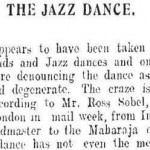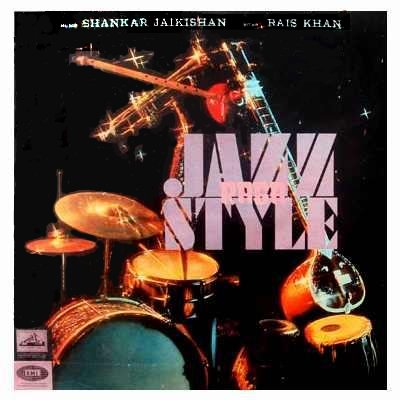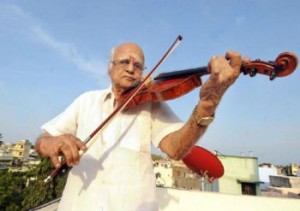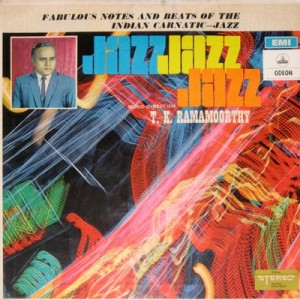Sees Need of Indian Blend to Save Music of America
Hindu Scholar Regards Jazz as Atrocity – Urges Compositions with ‘Atmosphere’ to Supplant It
That intriguing headline from December 1922 drew me to spend a pleasant afternoon at the New York Public Library for the Performing Arts at Lincoln Centre last fortnight. It had come up in a random internet search and as I read it, I knew I had to track down the entire piece. It is, after all, the earliest evidence I have seen of anyone thinking about the genre that, 45 years later, would come to be called “Indo-jazz fusion”.
The article had appeared in Music Trades, a journal for North American sellers of musical instruments and sheet music, and accessing it proved much easier than I imagined. Having struggled with clunky Indian libraries through much of my project, I was astonished at the enthusiasm demonstrated by the staff at the New York Public Library in helping me find what I needed. An email to the institution’s website elicited an instant response, telling me at which branch the journal was available. Fifteen minutes after I presented myself at the reception desk, I had been issued a temporary membership number and found myself being handed a couple of reels of microfilm.

As I zipped through the pages, one article caught my eye. “Sam Fox Finds San Francisco Folks Favor Music of Better Type and Forsake Jazz”. Fox, whose name would later be adopted by a British woman famed for her prominent chest, was a music publisher from Cleveland. He told Music Trades in 1922 that “cheap blues [were] on the wane” and that “the public [was] turning to ballads with heart appeal”.
 His attitude wasn’t unrepresentative. In the early decades of the twentieth century, it was fashionable for sophisticated people everywhere to sneer at jazz. In April 1919, among the first times The Times of India mentioned this new kind of music, the paper noted, “London appears to have been taken by Jazz bands and Jazz dances and the clergy are denouncing the dance as indecent, immoral and degenerate.” The Times report was based on an interview with Ross Sobel, the bandmaster to the Maharaja of Cooch Behar who had recently arrived in the British capital, and he confessed that he found the jazz craze “inexplicable”.
His attitude wasn’t unrepresentative. In the early decades of the twentieth century, it was fashionable for sophisticated people everywhere to sneer at jazz. In April 1919, among the first times The Times of India mentioned this new kind of music, the paper noted, “London appears to have been taken by Jazz bands and Jazz dances and the clergy are denouncing the dance as indecent, immoral and degenerate.” The Times report was based on an interview with Ross Sobel, the bandmaster to the Maharaja of Cooch Behar who had recently arrived in the British capital, and he confessed that he found the jazz craze “inexplicable”.
Sobel’s views were mirrored in Music Trades by Harendranath Maitra, who was described as “one of India’s leading scholars, musicians and journalists”. At a lecture in the city of Buffalo on November 1922, Maitra was asked for his opinion on American music. “American jazz music?” he asked. “That is not music. It lacks rhythm and expression.” He predicted, “I think it will not last long.”
But Maitra had a solution: “America should blend some of the finer Hindu tones to enrich its music.” Jazz, he said, had only one redeeming quality – “it is lively”. Indian music, of course, was far superior. It is “really nature’s song to her beloved”. Enumerating its virtues, Maitra explained, “Music is religion. The two are inseparable. Indian music moves in a soft, flowing rhythm. More and more you get into its swing you will feel poise, balance and harmony you have never felt before. Around our music hovers an atmosphere of mystery.” His final recommendation: “American composers should strive to create a similar atmosphere around their compositions.”
As I noted in my article last week, this fusion of Indian music and jazz occurred in the Hindi film studios a couple of decades after Maitra’s speech in a rather organic way. Film composers eagerly mixed together a wide array of disparate elements in their scores and, aided by Goan arrangers with experience in Bombay’s swing bands, Hindi film soundtrack are among the best examples we have of functional fusions.
 Against the backdrop, it was only a matter of time before some composers tried to explore these ideas in an art-music context. In this article about the pianist Lucila Pacheco, I recalled Raga Jazz Style, the album made in 1968 by the Hindi film composers Shankar and Jaiskishan, who recruited some of their most talented jazz-loving sidemen to reinterpret Hindustani ragas.
Against the backdrop, it was only a matter of time before some composers tried to explore these ideas in an art-music context. In this article about the pianist Lucila Pacheco, I recalled Raga Jazz Style, the album made in 1968 by the Hindi film composers Shankar and Jaiskishan, who recruited some of their most talented jazz-loving sidemen to reinterpret Hindustani ragas.
 After I finished poring over Music Trades, I decided to prowl through the second-hand record stores in the East Village and, most serendipitously, came across a reissue of a similar project that had been recorded in 1969 by TK Ramamoorthy, the South Indian violinist who, in the 1950s and ’60s composed scores for more than 700 Tamil, Telugu and Malayalam films along with his colleague MS Viswanathan.
After I finished poring over Music Trades, I decided to prowl through the second-hand record stores in the East Village and, most serendipitously, came across a reissue of a similar project that had been recorded in 1969 by TK Ramamoorthy, the South Indian violinist who, in the 1950s and ’60s composed scores for more than 700 Tamil, Telugu and Malayalam films along with his colleague MS Viswanathan.
The liner notes to the album, exuberantly titled Jazz, Jazz, Jazz, explain – as was almost compulsory for similar projects of that era – that jazz and Indian classical music are both improvisational forms: “The music is conceived and performed in the same instant of creation, within the limitation of the fundamental pattern of notes”. It isn’t easy to mix Carnatic and jazz, the writer said, because this “requires a complete understanding of these two diverse systems and therefore a creative talent of high order”. The writer concluded, “All one can say about these…compositions is ‘listen to them you must’.” I wonder what Harendranath Maitra would have made of this.



3 comments
This may be slightly off-topic but is in keeping with the theme of genre busting/stretching by musicians who earned their bread & butter working in Indian Film music. You may already know of Charanjit Singh and the record he put out in 1982 that predates acid house/techno. The record has be reissued on CD this last year. Backstory is here http://is.gd/yydvVT http://is.gd/rg0F9g reissue: http://is.gd/KEejCs
I look forward to your posts eagerly await your book. Having spent my early childhood in Goa I am a sucker for the Konkani tunes.
Great piece Naresh, as usual.
Here’s something for you Murari
http://www.soulseduction.com/world/item_detail.php?ItemID=179996
And for those who want to take a small detour to Hindi Film Instrumental albums of the earlier years, here’s the link
http://radiodiffusion.wordpress.com/category/india/
Thanks, Atul. Those are great links…